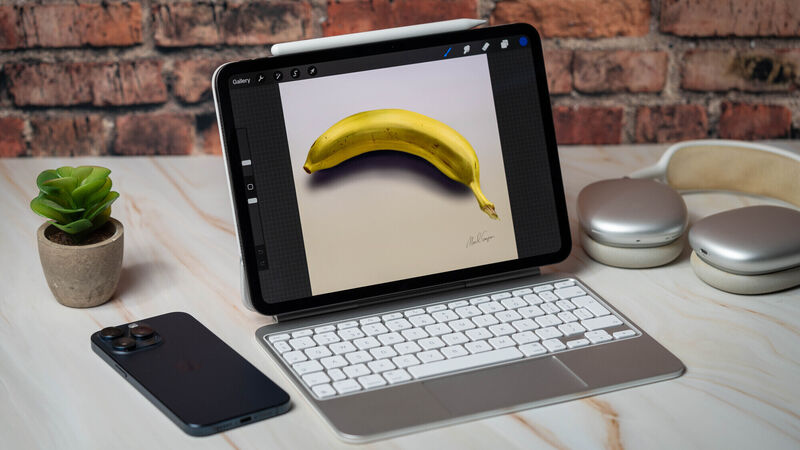Apple iPad Pro M4: The best iPad yet, but not an essential upgrade for everyone

Apple iPad Pro 2024. Picture: Noel Campion.
Having spent about a month with Apple’s new iPad Pro M4, I can confidently say it is the best iPad you can buy. The iPad Pro M4 excels in performance, content consumption, and general tablet tasks. However, despite its impressive specs, it may not be the right upgrade for everyone.

One of the most noticeable changes in the iPad Pro M4 is its redesigned body. It is significantly thinner and lighter than its predecessor, making it easier to handle, especially for the larger 13-inch model. This design tweak enhances portability, making it less cumbersome to use on the go. I’ve been testing the 11-inch version. While I prefer the larger 13-inch iPad Pro for productivity and especially drawing in Procreate, the smaller form factor is much easier to manage.

Apple’s transition to OLED displays for the Pro model is a significant leap. The new tandem OLED display features two OLED panels stacked on each other, resulting in a much brighter and more vibrant display.
Although the previous mini LED model had the same peak brightness of 1600 nits, the new OLED model's sustained brightness is 1000 nits, while the previous model was only 600 nits.
The OLED display offers deeper blacks and higher contrast without sacrificing brightness. Over the past few weeks, watching content on the iPad Pro 11 has been a visually stunning experience. One of the first things I noticed about the new display is the pixel response times. In the previous iPad Pro display, you can see ghosting, especially when you scroll slowly. The new Tandem OLED technology has a near-instant pixel response with virtually no visible ghosting. This makes it much better for games and for going through social feeds or browsing – pretty much any task that involves scrolling.
However, while the new display is undoubtedly superior, the difference may not justify an upgrade if you already own the mini LED model. The enhanced display is most noticeable in content consumption and gaming, where the full-screen experience truly shines. The new display is stunning for media consumption, such as watching the latest movies or TV shows, especially if they support Dolby Vision. However, the display upgrade may seem excessive for browsing or scrolling through social feeds or even general productivity tasks.
As a side note, the 13-inch and 11-inch models have slightly different display aspect ratios. The 13-inch iPad has a 4:3 display, while the iPad Pro 11 has a 1.43:1 screen aspect ratio.
This means whether you're watching movies on YouTube or through apps like Netflix or Prime Video, you'll see larger black bars when using the larger iPad Pro. Although you can enlarge the video to fill the screen, doing so will cause you to crop out more content because of the smaller aspect ratio.
The iPad Pro's M4 chip is the heart of its incredible performance. This second-generation 3-nanometer technology features a powerful CPU, a 10-core GPU, and advanced AI capabilities, enabling complex workflows and high-end projects. Apps like ZBrush, used by major movie and game studios, take full advantage of the M4 chip, allowing artists to easily and precisely work on detailed 3D meshes.
Apple skipped the M3 chip and moved directly to M4, yet many of the AI features promised have yet to materialise, though WWDC is around the corner. Without significant software to leverage the M4’s capabilities, the performance difference remains largely theoretical. For now, the M1 and M2 iPads perform nearly as well in most everyday applications.
Despite the impressive benchmark results from my testing, compared to my old iPad Pro M1, most users' real-world performance gains over the M1 and M2 chips are less pronounced.
My favourite iPad app, Procreate, doesn’t seem smoother or faster on the M4, but there will be a new update to take advantage of Apple Pencil Pro, and we may see further updates to features that may take advantage of the M4.
Despite its thinner design, the iPad Pro M4 maintains a battery life similar to that of its predecessor, thanks to the efficiency of the M4 chip. Would users have preferred a slightly thicker design with a larger battery, which might have been a better trade-off for extended use?

Apple has made an interesting change to the iPad Pro camera setup which now comes with a 12MP wide camera but the ultra-wide rear camera has been removed, which may disappoint some users.
Finally, the Pro model front-facing camera has been relocated from the portrait to the landscape edge, a welcome change for users like me who primarily use the iPad in landscape mode. The 1080p FaceTime camera with Centre Stage remains excellent for video calls, and the new orientation feels more natural.
The new Magic Keyboard is a standout accessory for the iPad Pro M4. Its aluminium base adds a premium feel, and the redesigned keyboard includes a larger trackpad with haptic feedback, enhancing the overall experience. I love the new function row, which provides quick access to essential controls like screen brightness, volume, and media controls.
The larger trackpad is much better, and the keys feel great when typing. However, the 11-inch version I used felt a little cramped, and the weight of the iPad meant it was top-heavy, easily falling over on my lap or while using it on a soft surface. It works perfectly on a hard surface like a table.

The new Apple Pencil Pro is amazing. It features pressure sensitivity, and the new barrel roll function allows you to rotate the pencil in your hand to use different parts of the tip, mimicking a real pencil or highlighter.
Hovering with the Pencil lets you see where you’re about to make a mark before actually doing so, which is extremely useful for precise work. The software-created shadow changes based on the selected tool, providing visual feedback that you’re writing where you intend to.
One of the coolest features is the squeeze gesture. Anywhere along the neck of the Pencil, from about the midpoint up, you can squeeze to bring up a contextual menu. There’s no actual button; instead, pressure sensors combined with a vibration motor provide tactile feedback, making it feel like you’ve clicked something.
The double-tap feature lets you quickly switch between options without navigating through menus.

I was able to test many of the new features in first-party apps such as Notes and Freeform, but unfortunately, the one app I really wanted to test it in was Procreate, and it hasn’t been updated yet.
The Apple Pencil remains unmatched for note-taking and drawing, but many of the new features are nice to have but not revolutionary, and I wouldn’t feel the need to upgrade to the new iPad Air or iPad Pro to get the Apple Pencil Pro.
While some may suggest the iPad is a laptop or even a desktop replacement, I see it as a companion to my MacBook Pro. It can do most of the things my MacBook Pro can, just not as well. I'm not at all convinced that Apple should just allow users to run MacOS on the iPad because it wouldn’t be an iPad then but rather a touchscreen Mac.
Apple is a victim of their success because the M1 or M2 iPad Pro, or even the iPad Air, remains sufficient for most users. Unless you need the absolute best display and slightly improved performance for specific AI applications, upgrading to the M4 might not be necessary.
The iPad Pro M4 is an absolute powerhouse with remarkable upgrades to Its display, performance, and accessories, which set it apart from previous models. However, these enhancements may need to be more compelling to justify the high price, especially for users with the M1 or M2 models. The iPad Pro 11 M4 starts at €1,229 for 256GB and rises quickly from €1,959 for 1TB, encroaching into high-spec MacBook territory. The iPad Pro 13 M4 starts from €1,579 for 256GB and tops out at €3,169 for the cellular model with 2TB and a new antiglare nano-textured glass finish.











